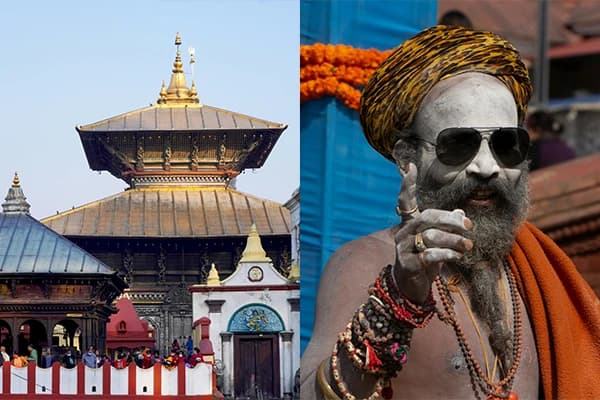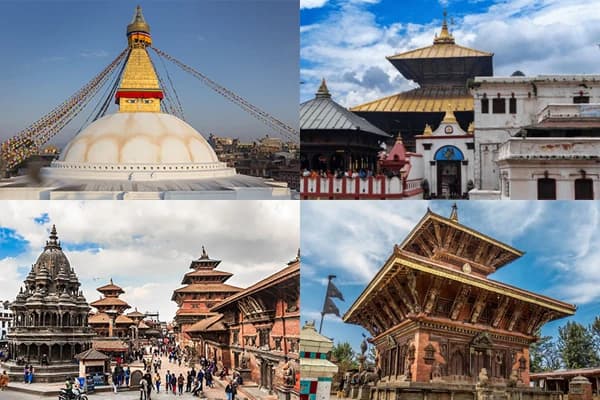Top Viewpoints in the Everest Region in 2025
- Kala Patthar (5,545m) - The Closest Iconic View of Everest
The Kala Patthar viewpoint is the highest accessible viewpoint for the trekkers to get breathtaking views of Mount Everest without requiring technical skills like climbing skills. It is located on the south ridge of Pumori above Gorak Shep.
The viewpoint offers panoramic views of the snowcapped peaks like Everest, Nuptse, Lhotse, Changtse, and Pumori along with the Khumbu Icefall vistas. It is perfect for the wide-angle photography of the prominent peaks, as it offers direct views of these peaks.
It is one of the best places to see Everest among accessible vantage points in 2025. You can do the multi-day trek, like the everest base camp trek, to reach the Kala Patthar viewpoint. The best time to hike to the viewpoint is before the sunrise.
- Gokyo Ri (5,357m) - The Underrated Gem
The Gokyo Ri is a popular viewpoint that even competes with the classic Everest Base Camp trek viewpoints for the views of the snowcapped peaks like Everest and Lhotse. It is located near the Gokyo village and Gokyo Lakes.
From Gokyo Ri, you can enjoy the views of the popular peaks like Mount Everest, Lhotse, Makalu, and Cho Oyu. It also provides the broader Himalayan panorama with the turquoise Gokyo Lakes vistas.
The longest glacier in Nepal, Ngozumpa Glacier, can be captured from there along with the golden sunrise and sunset lighting on the snowy peaks and tranquil lakes.
The everest base camp trek via gokyo lakes becomes the best option and way to reach Gokyo Ri and witness the Gokyo Ri sunrise. It is the less crowded trail as compared to the Everest base camp trek and offers cultural experiences too.
- Tengboche Monastery Viewpoint (3,867m) - Spiritual + Scenic
The tengboche monastery viewpoint is an important Buddhist pilgrimage site, a viewpoint, and a cultural center in the Everest area. It is the popular highlight of the everest base camp short trekking route. It is perched perfectly on the mountain ridge.
From the monastery, the peaks like Mount Everest, Lhotse, Nuptse, ama dablam, Kangtega, and Thamserku are visible. The views become more beautiful during the sunrise.
The place is at the perfect place for the natural settings, like the intersection of the Dudh Koshi and Imja Khola Valleys, and surrounded by the rhododendron forests. The photographers can get a clear shot of the Ama Dablam and Everest ranges.
To reach one of the best viewpoints in the Everest region, the Tengboche Monastery viewpoint in 2025, you can do the multi-day luxury everest base camp trek. The mountain vistas of Nepal seen from this monastery allure other tourists too.
- Everest View Hotel (3,880 m) - The Luxury Lookout
Everest View Hotel is a hotel cum luxury viewpoint popular as a scenic spot with a warm cup of tea and a premium Everest view. It is nestled along the Syangboche Ridge above the namche bazaar.
From the hotel, you can capture some of the best views of the peaks like Mount Everest, Lhotse, Ama Dablam, Thamserku, Taboche, Kangtega, and Kongde Ri. The additional Himalayan landmarks that can be seen at a distance are Khumbila, Nuptse, and Kusum Kanguru.
For photographers, you can capture Everest, Lhotse, Ama Dablam, Nuptse, and Thamserku in a single frame from terraces, balconies, or your room window. The sunrise and sunset views look awesome.
It is accessible from the short hike from the Namche Bazaar. Or you can choose the mount everest view trek to enjoy both adventure and scenic views. Or, you can also try the everest helicopter view tour in 2025 season.
- Nangkartshang Peak (5,083 m) - Dingboche’s Hidden Viewpoint
Nangkartshang Peak is a viewpoint located just above the village of dingboche in Nepal’s Khumbu region. It is a destination known for the acclimatization day hike with wild views. It is great for capturing Island Peak and Lhotse in 2025.
This peak offers panoramic views of the snowcapped mountains like Cho Oyu, Ama Dablam, Makalu, Lhotse, Kangtega, Thamserku, Taboche, Cholatse, and Nuptse, along with the vistas of the Imja Valley, glaciers, and alpine lakes.
The Imja Valley landscapes with sweeping vistas of the glacier below can be framed along with additional wide-angle photos of Dingboche village. The open exposure from the peak’s elevation is best for capturing dramatic lighting-especially during sunrise or sunset.
To reach the peak, you can do the multi-day treks like the Everest Base Camp Trek (12 days) and a hike from Dingboche. It is also the popular Viewpoint hike in Khumbu, loved by tourists. This destination is often skipped but incredibly rewarding.
- Pangboche Village & Ridge (3,985 m) - Local Life & Landscape
Pangboche village & ridge is one of the best Himalayan viewpoints that offers cultural and natural experiences in 2025.
From the ridge and village, you can witness the snowcapped peaks like Mount Everest, Lhotse, Ama Dablam, Thamserku, Nuptse, Kangtega, and Taboche. Additionally, the village also offers rich cultural traditions and Tibetan-Sherpa-influenced architecture.
In the early morning and the late afternoon, the snowcapped peaks bathe in the golden and pink hues. The ridge settings allow a creative atmosphere with peaks. Also the daily activities like villagers farming, herding yaks, weaving, or carving wood are worth capturing as the high-altitude life.
The everest base camp trek with helicopter return option became a perfect fit for those who wanted to enjoy the views from the Pangboche village and ridge. Try to go to the viewpoint near Pangboche Gompa for striking Everest vistas.
- Renjo La Pass (5,360 m) - The High Mountain Panorama
Renjo La Pass is one of the three major mountain passes in the Khumbu region that connects the Gokyo Valley with the Bhotekoshi Valley.
This pass is popular for the views of Mount Everest, Makalu, Cho Oyu, Gyachung Kang, Taboche, the Rolwaling Range, and Pachermo. Additionally, you can also see the Gokyo Lakes and Ngozumpa Glacier from there.
It is one of the scenic spots in Nepal, offering Everest, Gokyo Lakes, and the Rolwaling range all in one frame. Early mornings and late afternoons in the autumn or spring give the best golden-hour lighting and lake reflections.
For this destination, the everest three pass trek is the best option inn 2025. It may be challenging but is also quieter.
Tips for Catching the Best Views in 2025
- Aim for the sunrise or sunset time for the warmest and most dramatic light on the mountains.
- Plan your itinerary during the pre-monsoon or post-monsoon periods for the best visibility.
- Prepare for the altitude and plan extra days for rest and acclimatization so that the altitude sickness doesn't ruin your time.
- Bring the DSLR or mirrorless camera with a wide-angle lens for the best landscape views and a lightweight tripod for stability.
- Consider taking helicopter tours, such as the Everest helicopter tours, to enjoy aerial views in a short amount of time.
- Try to book the lodges that are near the major viewpoints to catch both sunrise and sunset without rushing.
- Keep the spare batteries warm & use the waterproof covers and padded bags to shield gear so that you don’t miss the shot for any reason.
Conclusion
From the classic Kala Patthar to the underrated gems like Nangkartshang, the Everest region offers several paradises for the photographers as well as trekkers. It’s like visiting a haven away from the hustling and bustling life, a quick escape. To fully experience the Everest region, try adding the exploration of other hidden gems and off-the-beaten-path trails too.
FAQs
- Do I need permits for these places in 2025?
Yes, the permits are required to visit the viewpoints even in 2025. There are two mandatory permits: the Sagarmatha National Park Entry Permit and the Khumbu Rural Municipality Permit. Both permits can be obtained at the Monjo checkpoint.
- Which is best for acclimatization?
The best acclimatization destinations are the Nangkartshang Peak near Dingboche and the Everest View Hotel near Namche Bazaar.
Don’t just scroll through dreamscapes - come witness the Himalayas in full cinematic glory with us. Checkout the best everest region treks now.





